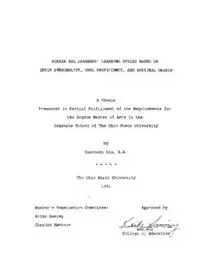
KOREAN ESL LEARNERS' LEARNING STYLES BASED ON THEIR PERSONALITY, ORAL ... PDF
Preview KOREAN ESL LEARNERS' LEARNING STYLES BASED ON THEIR PERSONALITY, ORAL ...
KOREAN ESL LEARNERS’ LEARNING STYLES BASED OM THEIR PERSONALITY, ORAL PROFICIENCY, AND NAVISNAL ORIGIN Acthesis Presented in F: ial Pulgiiiment of the Reg the dogroe Master of arte in the Graduate School of The Ohio State University by Eunyoung KL, B.A. whe Ohio state University Peer master's Rxamination Committe: Approved by Keiko Sanimy Charles Hancoce av ioE ze coliege 0: sducation’/ ‘To my husband ACRNOWLEDCIIEGTS I express appreciation to of the instructors uno participated in this study. My deep gratitude is expressed to Professor Keiko Saminy, my adviser, for hor unfailing support, veluable comments, and especially her confidence in me. I would like to extend ay gratitude to Professor Charles Hancock for hie patient guidance and encouragement: throughout ‘the period of my graduate studies. I woud also like to thank for theix generoun cooperation my fellow Korean graduate students whe participated, Kindly and sincer ) as the subjects in this study. Most of all, I give my neartreit thanks to my husband and my family in Korea for their support and encouragement during all the years of my education, aa vara, November 18, 1965 Born - Seoul, Korea 1967 B.A. in English Education korea University Seoul, Korea 1987 — English Examination congultant Joongang Educational Institute Seoul, Korea FIELDS OF STUDY Major Field: Education Minor Field: Foreign Language Education studies in TESOL TABLE OF CONTENTS DEDICATION ii ACKNOWLEDGMENT iii VITA iv LIS? OF TABIRS LIS? OF FIGIRES CHAPTER, PAGE I. THE PROBLEM =: Introduetian — 1 Purpose of the study 5 Research Questions | — 6 Theorotical Bases 7 Definitions of Terms ~ wy Agnamptions = 16 Significance of the Study an II. LETERATURE REVIEW = 20 introduction = 20 sone Characteristics and Taxoncnies of Learner strategies 20 Learnor Factors and the choice of Stratogies 2 The Characteristics of Successful Learner Strategies 3 Negative Aspects of Learner strategies 43 Sumtary a8 TIT. DESIGN & PROCKDURES Population Sample Desion Ingtrunents Procedures Data analysis Pilot study — IY. ANALYSTS OF THE DATA ~ overview of the Data statistical Analysis of the Data A. The Characteristics of 104 Subjects = B. The Characteristics of 105 Subjects — c. Similarities and Differences batween 104 and 105 Subjects ¥. SUMMARY, CONCLUSIONS & DISCUSSIONS overview Discussion of Findings Implications Recommendations tor Further Research — Limitations — APPENDICES umopmy LIST OF REFERENCES STILL Questionnaire Reductive Strategy Questionnaire Persona} ity Questionnaire Background Quee tionnaire Language Questionnaire ALetter — 1.189 OF TABLES ‘TABLE PACH 1. The Frequency of Reductive Strategy Scores Bl 2. The Frequency of Menory Strategy Scores 52 2. The Frequency ef Cognitive Strategy Scores 52 4. The Frequency of compensation Strategy Scores --- 53 5. The Yrequency of Metacognitive strategy Scores -- 53 6. The Frequency of Affective Strategy Scares 53 7. The Frequency of Social Strategy Scores sa 8. ‘Te Frequency of SILL strategy Scores — 54 9. The Froquency of Risk-Taking Scores 54 10. the Frequency of Sociability Scores oo 11. the Frequency of Discomfort Scores ~ 28 12, The Frequency of Personality Scores ~- oo 13, Ridit analysis tor the Tendency of Wisk-Taking, Seciability, and Discomfort 57 14. Ridit Analysis for the Tendency of soclanility and Discomfort 56 15. Kidit Analysie for the Use of Reductive Strategy and Discomfort Tendency 59 16, Ridit Analysis for the Use of Reductive Strategy and Sociability Tendency 6a 17. Ridit analysis tor the Use of Keductive Strategy and SILL strategy - 62 ih te. as. 20. al. 22. 22. Ridit Analysia for the Tendency of Risk-Taking and Discomfort ~ Ridit analysis for the Tesdency of Sociability and Bisconfort — Ridit Analysis for the Use of Reductive Strategy and Discomfort Variable Ridit Analysia for the Use of Reductive Strategy and SILL strategy ~~ Ridit analysia for the Use of SILL Strateay ~ Ridit Analysis for the Use of Reductive strategy oo os 5 6 67 oe LIST OF FIGURES FIGURE PAGE a ‘The Intermix of Learner status, Practice, and strategy Variables in the Learning process stern’s Model for Examination of Second Language Learning 25 ‘the Comparison of Parsonality Traits ~ 60 ‘The Comparison of SILL Use ~ 63 CHAPTER I ‘THE PROBLEM Tntreduct ion ‘he conmunicative approach to second Language Learning has encouraged learners to take greater responsibility for their cun learning, and its principles have stimulated the use of appropriate, positive learning strategies. varallel with the focus of research, there is growing intorest in identifying learning behaviors and thought processes used by language learners. Tae idea that students con be Laught to be more effective and creative leamers has pean explored in relation to recent advances in cognitive psychology and other principles. with the advent of Interlanguage theory as well as the enexgenco of cognitive paycholoay, the importance of learner strategy has been demonstrated by a growing body of strategy reseerch studies. There have peen nunerous books and articles discussing the identification, importance, impl cations, and teachability of learner strategies. Instrumente for measuring then have peen
